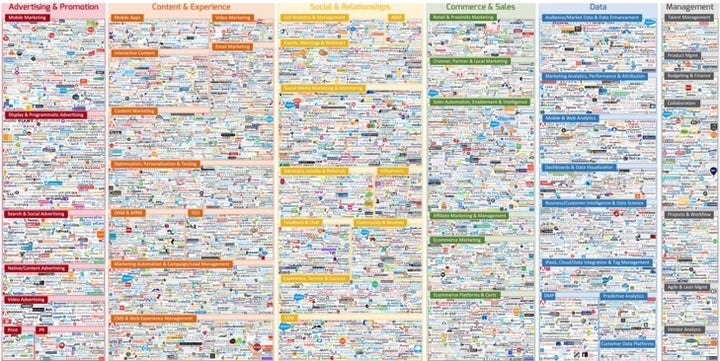
Thanks to Scott Brinker at chiefmartech.com for sharing the 2017 Marketing Technology Supergraphic. I appreciate every year seeing the updated technology landscapes along with the insights and commentary provided by Luma Partners. If you are having trouble making out any of the details, it’s not your eyesight. Over 5000 companies are included on the landscape, astoundingly up from 150 in 2011.
Wow. Does the Chief Marketing Officer really need 5000 – and growing - choices? Even within the super-graphic’s sub-categories, any executive may find herself searching for just a few needles in the haystack. That short list will only include those needs that matter enough to command resources at the expense of some other priority: software will be licensed, planned into the tech stack, fed by data to produce decisions, and provide leverage for media selection, offer testing, user experience, servicing, personalization, team collaboration, or to meet any of the other demands of a modern marketing organization.
The super-graphic conveys at least two messages:
- Lots of engineers see that marketing is a function continuing to live with daily disruption, and want to help, or see an open window at least to build solutions that can create investor value.
- With so many solutions out there it’s reasonable to question where the value and meaningful differences are among them. Where has tech product specialization become so deep that solutions are not relevant enough to be worth the CMO’s pursuit?
Direct marketers have long subscribed to the orthodoxy that choice depresses response. While not always the case, certainly when presented with an overwhelming number of choices buyers tend to shut down. Without a framework relevant to the CMO’s needs, having 5000+ options on one slide (while a remarkable feat of design, even organized into tech-based categories with add-on zoom-in capability) will feed decision-making paralysis.
There is a way to not get swallowed by the mar-tech vortex, one that is remarkably low tech and depends more upon critical thinking, collaboration, customer focus and having clear commercial goals. In this context, software is the enabler, the means but not the end.
That way? Be clear on what the business strategy is. How does the business strategy translate into the short list of marketing priorities – those that constitute a 20/110 effort-for-impact calculation? This means the 20% of activity that will make 110% of the difference. (I prefer 20/110 thinking to the more common 80/20 – let’s admit that some of the decisions marketers make end up dragging down results, and that the headlines that dominate team appraisals of progress tend to focus on a short list versus the totality).
Strategy comes down to:
- The starting point: Where are you now?
- The destination: Where do you want to be?
- The route: How do you anticipate getting there?
- The rationale: Why does any of this matter?
The focus for any CMO trying to decide where to start and where to put her undoubtedly too-scarce resources is to be confident about:
- What customer problems the brand wants to solve that will allow stand out status in the hearts and minds of our users.
- And, what marketing capabilities (technology and otherwise) are needed to ensure the brand gets to the solution(s) that widen competitive advantage and grow user preference.
Mar-tech along with all of the other advanced technologies available today should be chosen because they can help the brand enable remarkable differentiation — in the hearts and minds of customers. With strategy in hand, it is possible to make smart decisions and tradeoffs for the right reasons, about how to prioritize mar-tech investments for business leverage. Then, frameworks such as this complex snapshot of what technology can do for marketing become incredibly useful places to start searching for the appropriate enablers.
Amy Radin is a business strategist, board member, and digital & marketing transformation adviser who works with executives to grow businesses by solving real marketplace problems. Visit www.amyradin.com or contact amy@amyradin.com to find pragmatic, non-obvious answers to your growth aspirations and challenges.
This post also appears in Amy’s columns on Medium, Insurance Thought Leadership, and LinkedIn .
